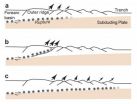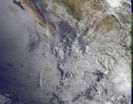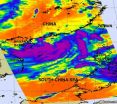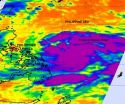(Press-News.org) An international team of geoscientists has discovered an unusual geological formation that helps explain how an undersea earthquake off the coast of Sumatra in December 2004 spawned the deadliest tsunami in recorded history.
Instead of the usual weak, loose sediments typically found above the type of geologic fault that caused the earthquake, the team found a thick plateau of hard, compacted sediments. Once the fault snapped, the rupture was able to spread from tens of kilometers below the seafloor to just a few kilometers below the seafloor, much farther than weak sediments would have permitted. The extra distance allowed it to move a larger column of seawater above it, unleashing much larger tsunami waves.
"The results suggest we should be concerned about locations with large thicknesses of sediments in the trench, especially those which have built marginal plateaus," said Sean Gulick, research scientist at The University of Texas at Austin's Institute for Geophysics. "These may promote more seaward rupture during great earthquakes and a more significant tsunami."
The team's results appear this week in an article lead-authored by Gulick in an advance online publication of the journal Nature Geoscience.
The team from The University of Texas at Austin, The University of Southampton in the United Kingdom, The Agency for the Assessment and Application of Technology in Indonesia and The Indonesia Institute for Sciences used seismic instruments, which emit sound waves, to visualize subsurface structures.
Early in the morning of Dec. 26, 2004 a powerful undersea earthquake started off the west coast of Sumatra, Indonesia. The resulting tsunami caused devastation along the coastlines bordering the Indian Ocean with tsunami waves up to 30 meters (100 feet) high inundating coastal communities. With very little warning of impending disaster, more than 230,000 people died and millions became homeless.
The earthquake struck along a fault where the Indo-Australian plate is being pushed beneath the Sunda plate to the east. This is known as a subduction zone and in this case the plates meet at the Sunda Trench, around 300km west of Sumatra. The Indo-Australian plate normally moves slowly under the Sunda plate, but when the rupture occurred, it violently surged forward.
The Sunda Trench is full of ancient sediment, some of which has washed out of the Ganges over millions of years forming a massive accumulation of sedimentary rock called the Nicobar Fan. As the Indo-Australian plate is subducted, these sediments are scraped off to form what's called an accretionary prism. Usually an accretionary prism slopes consistently away from the trench, but here the seabed shallows steeply before flattening out, forming a plateau.
Subduction earthquakes are thought to start tens of kilometers beneath the Earth's surface. Displacement or "slip" on the fault, as geologists call it, propagates upwards and generally dissipates as it reaches weaker rocks closer to the surface. If it were an ordinary seismic zone, the sediment in the Sunda Trench should have slowed the upward and westward journey of the 2004 earthquake, generating a tsunami in the shallower water on the landward (east) side of the trench.
But in fact the fault slip seems to have reached close to the trench, lifting large sections of the seabed in deeper water and producing a much larger tsunami.
This latest report extends work published last year in the journal Science that found a number of unusual features at the rupture zone of the 2004 earthquake such as the seabed topography, how the sediments are deformed and the locations of small earthquakes (aftershocks) following the main earthquake. The researchers also reported then that the fault zone was a much lower density zone than surrounding sediments, perhaps reducing friction and allowing a larger slip.
INFORMATION:
Funding for the research was provided by the U.S. National Science Foundation (NSF) and the UK Natural Environment Research Council.
A copy of the paper, "Updip rupture of the 2004 Sumatra earthquake extended by thick indurated sediments," is available at: http://www.nature.com/ngeo/journal/vaop/ncurrent/full/ngeo1176.html
Stiff sediments made 2004 Sumatra earthquake deadliest in history
2011-06-23
ELSE PRESS RELEASES FROM THIS DATE:
Experience a Piece of History That Will Never be Repeated: Two Celebrity Magic Shows in Commemoration of Legendary Magician and Film Star John Calvert's 100th Birthday!
2011-06-23
The shows will feature some of magic's biggest stars, including Liu Chen (Asia's number one magic superstar), Jeff McBride (Las Vegas star seen on Criss Angel's "Mindfreak"), David & Dania (award-winning quick-change act seen on "America's Got Talent"), and many more! Each show is only $45. For an additional $80 patrons can attend lectures and visit the dealer room, commingling with some of the world's greatest magicians and learning their most mystifying techniques!
The guest of honor, John Calvert, was the first magician to perform on Broadway ...
ISL - Building a New Future on Agricola St.
2011-06-23
ISL web marketing and development is pleased to announce it has relocated its head office to 5777 West St. The newly constructed 3 1/2-story building on the corner of West and Agricola St. will be home to the company and its 30 employees.
The move comes during the company's 15th year in operation. From the early stages of the Internet, ISL has been providing web based marketing solutions for its clients. The company has grown across the country, with offices in Halifax and Vancouver and is now the largest Internet marketing firm in Atlantic Canada.
Over the last ...
NASA and NOAA satellite video shows Tropical Storm Beatriz fizzle in 6 hours
2011-06-23
VIDEO:
GOES-11 satellite imagery from June 20 at 13:00 UTC (9 a.m. EDT/6 a.m. PDT) until June 22 at 1315 UTC (9:15 a.m. EDT) as Beatriz battered southwestern Mexico's coastline and...
Click here for more information.
Satellite data from NASA and NOAA showed that Tropical Storm Beatriz went from a strong tropical storm to a remnant low pressure area in six short hours after running into Mexico's western mountains. An animation of imagery from the GOES-11 satellite showed ...
Hubble sees Pandora's Cluster
2011-06-23
A team of scientists studying the galaxy cluster Abell 2744, nicknamed Pandora's Cluster, have pieced together the cluster's complex and violent history using telescopes in space and on the ground, including the Hubble Space Telescope, the European Southern Observatory's Very Large Telescope, the Japanese Subaru telescope, and NASA's Chandra X-ray Observatory.
The giant galaxy cluster appears to be the result of a simultaneous pile-up of at least four separate, smaller galaxy clusters. The crash took place over a span of 350 million years.
The galaxies in the cluster ...
NASA sees heavy rainfall on southern side of Tropical Depression Haima as it nears Hong Kong
2011-06-23
Tropical Depression Haima, formerly known as 06W continues moving toward Hong Kong and NASA infrared satellite imagery shows strong rain-making thunderstorms in the southern quadrant of the storm. Rainfall is something that a rain-weary China doesn't need, so preparations are being made now.
Heavy rainfall is expected as Haima approaches in southern Taiwan, and also in southern areas of China's Fujian and Guangdong provinces, and Hainan Island. That heavy rainfall was spotted on an infrared image captured by NASA's Atmospheric Infrared Sounder (AIRS) instrument on June ...
NASA satellite sees massive Tropical Storm Meari headed for Taiwan
2011-06-23
The AIRS instrument on NASA's Aqua satellite captured an infrared image of the western North Pacific's seventh tropical depression become massive Tropical Storm Meari overnight. Meari is so large that it takes up almost the entire Philippine Sea and it's on track toward southeastern Taiwan.
Tropical Storm Meari's large area of cold thunderstorm cloud tops were captured on an infrared image from NASA's Atmospheric Infrared Sounder (AIRS) instrument on June 21 at 17:11 UTC (1:11 p.m. EDT). The strongest thunderstorms covered an area of hundreds of miles around what oddly ...
Tooth Pain a Sign of Allergy Season, Reports FocusedCareDental.com
2011-06-23
Everybody and his brother are reaching for tissues, eye drops and antihistamines to ward off the effects of pollen, mold and other seasonal allergy triggers. Some of America's 40 million sinusitis sufferers even have to resort to pain medicines to dull sinus-related headaches and tooth pain, says public health advocate Allan Melnick, a prominent clinical dentist in Encino, Calif.
"I have patients presenting with tooth pain, who don't realize it's linked to their sinus infection. They think they have a cavity, but the pain is actually a sinus 'plumbing' problem," ...
Toxic compounds in groundwater
2011-06-23
MADISON, WI, JUNE 22, 2011 -- Vinyl chloride is a cancer-causing compound formed from solvents in groundwater systems under anaerobic conditions. These solvents are used in many industrial applications around the world and often belong to the most encountered groundwater pollutants in industrialized countries. Groundwater is a major drinking water resource, and it is vital to determine if vinyl chloride can be further degraded into harmless compounds.
A group of scientists at Ecole Polytechnique Fédérale de Lausannne (EPFL) and the University of Neuchâtel, Switzerland, ...
Competition between brain cells spurs memory circuit development
2011-06-23
ANN ARBOR, Mich. — Scientists at the University of Michigan Health System have for the first time demonstrated how memory circuits in the brain refine themselves in a living organism through two distinct types of competition between cells.
Their results, published today in Neuron, mark a step forward in the search for the causes of neurological disorders associated with abnormal brain circuits, such as Alzheimer's disease, autism and schizophrenia.
"Much of our understanding of the brain's wiring has come from studying our sensory and motor systems, but far less is ...
Birds 'flap run' instead if flying over obstacles to save energy
2011-06-23
Why don't you ever see baby pigeons? For the same reason you don't see many chicks: they can't fly. It can take months for their partially developed wings and flight muscles to become airworthy, and by then the youngsters are almost fullygrown. However, long before their maiden flight, pigeon chicks probably put their developing wings to use, flapping as they run up steep branches. Brandon Jackson from the University of Montana, USA, explains that Ken Dial and his son first noticed this strange behaviour when filming chuckar chicks negotiating obstacles: instead of flying ...





